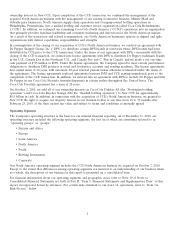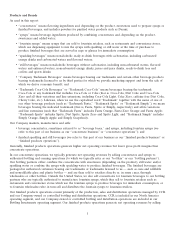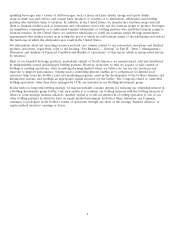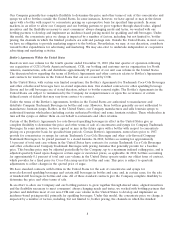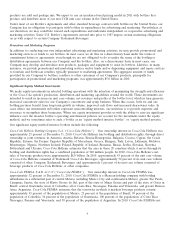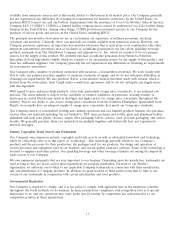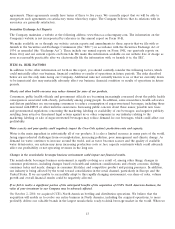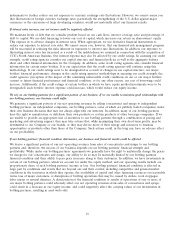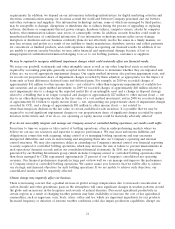Coca Cola 2010 Annual Report Download - page 14
Download and view the complete annual report
Please find page 14 of the 2010 Coca Cola annual report below. You can navigate through the pages in the report by either clicking on the pages listed below, or by using the keyword search tool below to find specific information within the annual report.The production, distribution and sale in the United States of many of our Company’s products are subject to the
Federal Food, Drug, and Cosmetic Act; the Federal Trade Commission Act; the Lanham Act; state consumer protection
laws; federal, state and local workplace health and safety laws; various federal, state and local environmental protection
laws; and various other federal, state and local statutes and regulations applicable to the production, transportation,
sale, safety, advertising, labeling and ingredients of such products. Outside the United States, the production,
distribution and sale of our many products and related operations are also subject to numerous similar and other
statutes and regulations.
A California law, known as Proposition 65, requires that a warning appear on any product sold in California that
contains a substance that, in the view of the state, causes cancer or birth defects. The state maintains lists of these
substances. Proposition 65 exposes all food and beverage producers to the possibility of having to provide warnings on
their products in California because it recognizes no generally applicable quantitative thresholds below which a warning
is not required. Consequently, the detection of even a trace amount of a listed substance can subject an affected
product to the requirement of a warning label. One or more substances that are currently on the Proposition 65 lists, or
that may be added in the future, can be detected in Company products at low levels that are safe. However, Proposition
65 does not require a warning if the manufacturer of a product can demonstrate that the use of the product in question
exposes consumers to a daily quantity of a listed substance:
• that is below a ‘‘safe harbor’’ that may be established;
• that is naturally occurring;
• that is the result of necessary cooking; or
• that is subject to another applicable exemption.
One of the two listed substances that can presently be detected in a Company product has been shown to be naturally
occurring. As to the other, the state has proposed, but not yet finally established, an inappropriately low safe harbor
level that is still subject to public comment and to potential legal challenge.
Bottlers of our beverage products presently offer and use nonrefillable, recyclable containers in the United States and
various other markets around the world. Some of these bottlers also offer and use refillable containers, which are also
recyclable. Legal requirements apply in various jurisdictions in the United States and overseas requiring that deposits or
certain ecotaxes or fees be charged for the sale, marketing and use of certain nonrefillable beverage containers. The
precise requirements imposed by these measures vary. Other types of statutes and regulations relating to beverage
container deposits, recycling, ecotaxes and/or product stewardship also apply in various jurisdictions in the United States
and overseas. We anticipate that additional, similar legal requirements may be proposed or enacted in the future at
local, state and federal levels, both in the United States and elsewhere.
All of our Company’s facilities and other operations in the United States and elsewhere around the world are subject to
various environmental protection statutes and regulations, including those relating to the use of water resources and the
discharge of wastewater. Our policy is to comply with all such legal requirements. Compliance with these provisions has
not had, and we do not expect such compliance to have, any material adverse effect on our Company’s capital
expenditures, net income or competitive position.
Employees
We refer to our employees as ‘‘associates.’’ As of December 31, 2010 and 2009, our Company had approximately
139,600 and 92,800 associates, respectively, of which approximately 4,900 and 17,900, respectively, were employed by
consolidated variable interest entities (‘‘VIEs’’). The increase in the total number of associates in 2010 was primarily
due to the impact of our acquisition of CCE’s North American business, partially offset by the sale of our Norwegian
and Swedish bottling operations to New CCE and the deconsolidation of certain entities due to the Company’s
adoption of new accounting guidance issued by the Financial Accounting Standards Board (‘‘FASB’’). As of
December 31, 2010 and 2009, our Company had approximately 70,400 and 11,700 associates, respectively, located in the
United States, including Puerto Rico, of which approximately 720 and 190, respectively, were employed by consolidated
VIEs.
Our Company, through its divisions and subsidiaries, has entered into numerous collective bargaining agreements. As of
December 31, 2010, approximately 18,600 associates in North America were covered by collective bargaining
12


